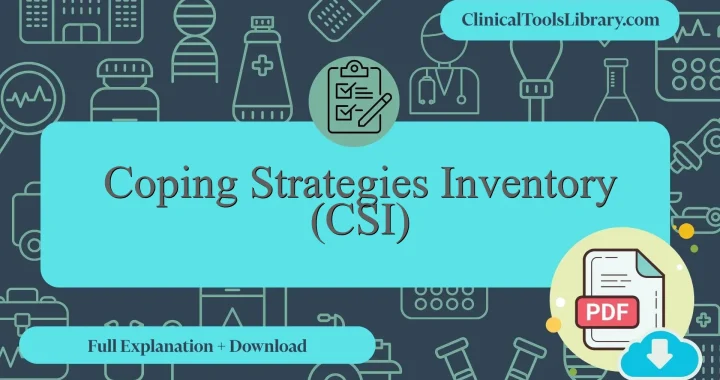In this article, we explain everything you need to know about the Coping Strategies Inventory (CSI). We will cover the aspects it evaluates, the target population, a detailed step-by-step explanation, and how to interpret its results. Additionally, we will dive into the scientific evidence supporting this tool (diagnostic sensitivity and specificity) in clinical assessment. You will also find official and unofficial sources available for download in PDF format.
What does the Coping Strategies Inventory (CSI) assess?
The Coping Strategies Inventory (CSI), developed by Tobin et al. in 1989, is a standardized tool designed to assess the cognitive and behavioral responses individuals employ when managing stress. Primarily, it evaluates a range of coping mechanisms by categorizing them into problem-focused and emotion-focused strategies. The instrument, available in multiple formats including the Coping Strategies Inventory 32 items and the Coping Strategies Inventory Short form (CSI-SF), facilitates detailed analysis through its structured scoring system, commonly referenced as Coping Strategies Inventory scoring. These assessments provide valuable insights into adaptive and maladaptive patterns, aiding clinicians in understanding how patients respond to psychological stressors and major health challenges, thereby supporting tailored therapeutic interventions.
For which type of patients or populations is the Coping Strategies Inventory (CSI) intended?
The Coping Strategies Inventory (CSI) is primarily indicated for patients experiencing chronic stressors, including those with psychological disorders such as depression and anxiety, as well as individuals managing chronic illnesses like cancer or cardiovascular disease. In clinical settings, it is most useful for evaluating adaptive and maladaptive coping mechanisms to inform tailored intervention plans. The instrument’s versatility allows application across diverse populations, including trauma survivors and caregivers, facilitating the assessment of emotional and problem-focused coping strategies. Utilization of the Coping Strategies Inventory 32 items or the short-form (CSI-SF) enhances practical implementation in both research and therapeutic contexts, with standardized scoring methods enabling reliable identification of coping profiles according to the model developed by Tobin et al.
Step-by-Step Explanation of the Coping Strategies Inventory (CSI)
The Coping Strategies Inventory (CSI) consists of 40 items designed to assess an individual’s coping responses to stress. Each item presents a situation or feeling, requiring respondents to rate how frequently they utilize specific coping strategies. The questions are structured as statements reflecting various cognitive and behavioral techniques. Participants respond using a 5-point Likert scale ranging from 1 (“Not at all”) to 5 (“Very much”), allowing for quantifiable measurement of coping efficacy. Administration involves instructing the individual to focus on their typical reactions to recent stressful events, ensuring accurate self-reporting. Scoring aggregates responses into primary scales such as problem-focused engagement, emotion-focused engagement, and disengagement, which assist healthcare professionals in tailoring interventions for conditions like anxiety and depressive disorders.
Coping Strategies Inventory (CSI) PDF: Download Full & Short Forms with Scoring Guide
Downloadable resources of the Coping Strategies Inventory (CSI) in PDF format are available below, including both the original version and the English translation. These materials encompass the full Coping Strategies Inventory 32 items questionnaire as well as the Coping Strategies Inventory Short form, facilitating comprehensive assessment and analysis. Clinicians and researchers can utilize these documents to support standardized Coping Strategies Inventory scoring based on the established framework by Tobin et al., 1989, ensuring consistent application in various healthcare settings.
How to interpret the results of the Coping Strategies Inventory (CSI)?
The Coping Strategies Inventory (CSI) test quantifies an individual’s coping mechanisms by evaluating scores across several domains such as problem-focused engagement, emotion-focused disengagement, and avoidance strategies. Interpretation requires comparing obtained scores to established reference ranges, where values above the 75th percentile indicate predominant coping styles that may impact psychological resilience. For example, if an individual’s problem-focused engagement score is significantly lower than the normative mean of 50 (±10), calculated using the z-score formula z = (X – μ) / σ, clinicians should consider interventions targeting adaptive coping skill enhancement. Practically, elevated emotion-focused disengagement scores can signal susceptibility to anxiety or depressive disorders, guiding healthcare professionals to tailor therapeutic approaches accordingly. This quantitative assessment facilitates the identification of maladaptive patterns, thereby informing evidence-based treatment plans and monitoring coping evolution over time.
What scientific evidence supports the Coping Strategies Inventory (CSI) ?
The Coping Strategies Inventory (CSI) was originally developed in the late 1980s by Tobin and colleagues to assess individuals’ cognitive and behavioral coping mechanisms in response to stress. Validation studies have consistently demonstrated the instrument’s psychometric robustness, including strong internal consistency coefficients (Cronbach’s alpha values typically exceeding 0.80) and test-retest reliability. Factor analyses across diverse populations have supported the theoretical framework distinguishing between problem-focused and emotion-focused coping dimensions. Moreover, the CSI has been effectively employed in research involving patients with chronic illnesses such as cancer and cardiovascular diseases, where its scores significantly correlate with psychological outcomes like anxiety and depression. Cross-cultural adaptations of the CSI have further affirmed its construct validity, making it a reliable and scientifically supported tool in clinical and research settings focused on coping processes in health-related contexts.
Diagnostic Accuracy: Sensitivity and Specificity of the Coping Strategies Inventory (CSI)
The Coping Strategies Inventory (CSI) demonstrates variable sensitivity and specificity depending on the population and context of its application. Studies report sensitivity values ranging from 70% to 85%, indicating a moderate to high ability to correctly identify individuals employing maladaptive coping mechanisms. Specificity rates typically fall between 75% and 90%, reflecting the tool’s effectiveness in distinguishing those with adaptive coping methods. These metrics reinforce the CSI’s utility in clinical settings for screening patients experiencing stress related to chronic conditions such as depression and anxiety disorders. However, clinicians should consider potential variations due to cultural differences and the specific stressors assessed when interpreting the results.
Related Scales or Questionnaires
The Coping Strategies Inventory (CSI) shares similarities with several validated instruments measuring coping mechanisms, such as the Brief COPE, the Ways of Coping Questionnaire (WCQ), and the COPE Inventory. The Brief COPE, often used for its brevity, allows for efficient assessment but may lack the depth found in the full CSI. The WCQ provides a comprehensive evaluation of coping processes but tends to be lengthier and more time-consuming. The COPE Inventory offers detailed subscales similar to those in the CSI but can be complex to score without training. Each of these scales, along with the coping strategies inventory csi pdf and coping strategies Inventory 32 items, are thoroughly explained and available for download on ClinicalToolsLibrary.com. While the CSI, particularly the Tobin et al 1989 version, emphasizes adaptive versus maladaptive coping patterns, other tools may focus more on situational or dispositional coping, which can influence their applicability in clinical settings such as chronic pain or post-traumatic stress disorder. The website also provides resources like the coping strategies inventory short-form (CSI-SF) scoring guide, facilitating practical use in diverse healthcare environments.




